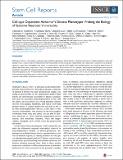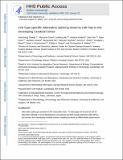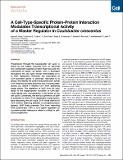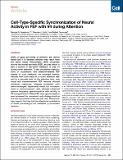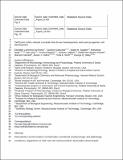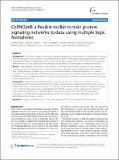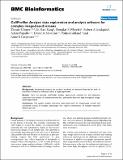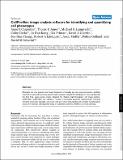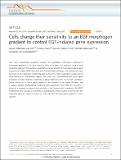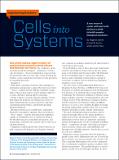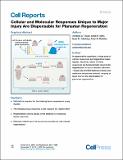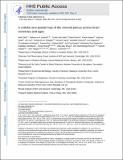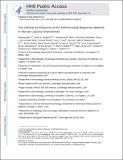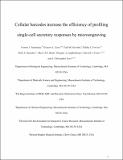Browsing MIT Open Access Articles by Title
Now showing items 5468-5487 of 55760
-
Cell-type Dependent Alzheimer's Disease Phenotypes: Probing the Biology of Selective Neuronal Vulnerability
(Elsevier BV, 2017-11)Authors Alzheimer's disease (AD) induces memory and cognitive impairment in the absence of motor and sensory deficits during its early and middle course. A major unresolved question is the basis for this selective neuronal ... -
Cell-type Specific Optogenetic Mice for Dissecting Neural Circuitry Function
(Nature Publishing Group, 2011-10)Optogenetic methods have emerged as powerful tools for dissecting neural circuit connectivity, function, and dysfunction. We used a Bacterial Artificial Chromosome (BAC) transgenic strategy to express Channelrhodopsin2 ... -
Cell-Type-Specific Alternative Splicing Governs Cell Fate in the Developing Cerebral Cortex
(Elsevier, 2016-08)Alternative splicing is prevalent in the mammalian brain. To interrogate the functional role of alternative splicing in neural development, we analyzed purified neural progenitor cells (NPCs) and neurons from developing ... -
A Cell-Type-Specific Protein-Protein Interaction Modulates Transcriptional Activity of a Master Regulator in Caulobacter crescentus
(Elsevier, 2010-07)Progression through the Caulobacter cell cycle is driven by the master regulator CtrA, an essential two-component signaling protein that regulates the expression of nearly 100 genes. CtrA is abundant throughout the cell ... -
Cell-Type-Specific Synchronization of Neural Activity in FEF with V4 during Attention
(Elsevier, 2012-02)Shifts of gaze and shifts of attention are closely linked and it is debated whether they result from the same neural mechanisms. Both processes involve the frontal eye fields (FEF), an area which is also a source of top-down ... -
CellComm infers cellular crosstalk that drives haematopoietic stem and progenitor cell development
(Springer Science and Business Media LLC, 2022)Intercellular communication orchestrates a multitude of physiologic and pathologic conditions. Algorithms to infer cell-cell communication and predict downstream signalling and regulatory networks are needed to illuminate ... -
CellNOptR: a flexible toolkit to train protein signaling networks to data using multiple logic formalisms
(BioMed Central Ltd, 2012-10)Background: Cells process signals using complex and dynamic networks. Studying how this is performed in a context and cell type specific way is essential to understand signaling both in physiological and diseased situations. ... -
CELLO: A fast algorithm for Covariance Estimation
(Institute of Electrical and Electronics Engineers (IEEE), 2013-10)We present CELLO (Covariance Estimation and Learning through Likelihood Optimization), an algorithm for predicting the covariances of measurements based on any available informative features. This algorithm is intended to ... -
CellProfiler Analyst: data exploration and analysis software for complex image-based screens
(BioMed Central Ltd., 2008-11)Background: Image-based screens can produce hundreds of measured features for each of hundreds of millions of individual cells in a single experiment. Results: Here, we describe CellProfiler Analyst, open-source software ... -
CellProfiler: image analysis software for identifying and quantifying cell phenotypes
(BioMed Central Ltd, 2006-10)Biologists can now prepare and image thousands of samples per day using automation, enabling chemical screens and functional genomics (for example, using RNA interference). Here we describe the first free, open-source ... -
Cells change their sensitivity to an EGF morphogen gradient to control EGF-induced gene expression
(Nature Publishing Group, 2015-05)How cells in developing organisms interpret the quantitative information contained in morphogen gradients is an open question. Here we address this question using a novel integrative approach that combines quantitative ... -
Cells into Systems
(American Society of Mechanical Engineers, 2010-11)The National Science Foundation has awarded a Science and Technology Center grant to a group of researchers to explore ways in which complex biological machines can be created. The new center is named Emergent Behaviors ... -
Cellular and Molecular Responses Unique to Major Injury Are Dispensable for Planarian Regeneration
(Elsevier, 2018-11)The fundamental requirements for regeneration are poorly understood. Planarians can robustly regenerate all tissues after injury, involving stem cells, positional information, and a set of cellular and molecular responses ... -
A cellular and spatial map of the choroid plexus across brain ventricles and ages
(Elsevier BV, 2021)The choroid plexus (ChP) in each brain ventricle produces cerebrospinal fluid (CSF) and forms the blood-CSF barrier. Here, we construct a single-cell and spatial atlas of each ChP in the developing, adult, and aged mouse ... -
Cellular and synaptic network defects in autism
(Elsevier, 2012-03)Many candidate genes are now thought to confer susceptibility to autism spectrum disorders (ASDs). Here we review four interrelated complexes, each composed of multiple families of genes that functionally coalesce on common ... -
Cellular and transcriptional diversity over the course of human lactation
(Proceedings of the National Academy of Sciences, 2022)<jats:title>Significance</jats:title> <jats:p>Human breast milk is the nutritional food source evolved specifically to meet the needs of infants, but much remains to be learned about its composition and changes ... -
The cellular architecture of the antimicrobial response network in human leprosy granulomas
(Springer Science and Business Media LLC, 2021)Granulomas are complex cellular structures composed predominantly of macrophages and lymphocytes that function to contain and kill invading pathogens. Here, we investigated the single-cell phenotypes associated with ... -
Cellular Barcodes for Efficiently Profiling Single-Cell Secretory Responses by Microengraving
(American Chemical Society, 2012-12)We present a method that uses fluorescent cellular barcodes to increase the number of unique samples that can be analyzed simultaneously by microengraving, a nanowell array-based technique for quantifying the secretory ... -
The Cellular Basis for Animal Regeneration
(Elsevier, 2011-07)The ability of animals to regenerate missing parts is a dramatic and poorly understood aspect of biology. The sources of new cells for these regenerative phenomena have been sought for decades. Recent advances involving ... -
Cellular biophysical markers of hydroxyurea treatment in sickle cell disease
(SPIE, 2017-04)Using a common-path interferometric technique, we measure biomechanical and morphological properties of individual red blood cells in SCD patients as a function of cell density, and investigate the correlation of these ...

